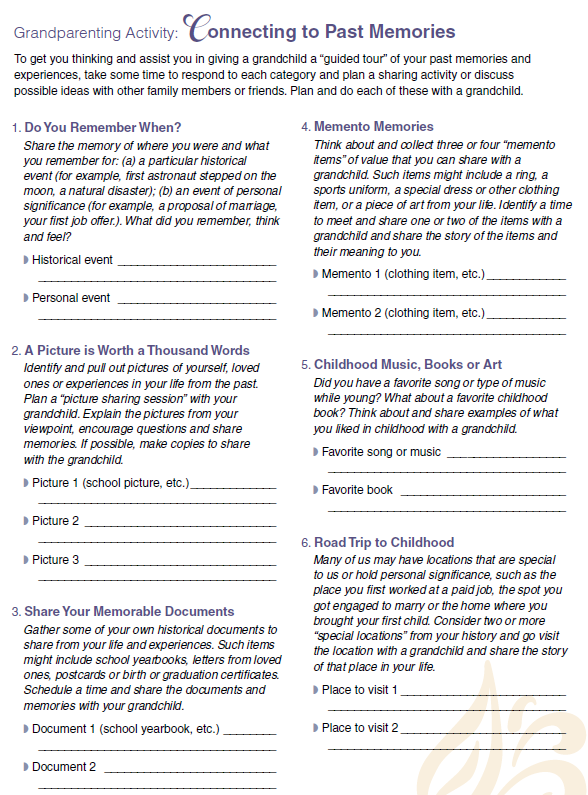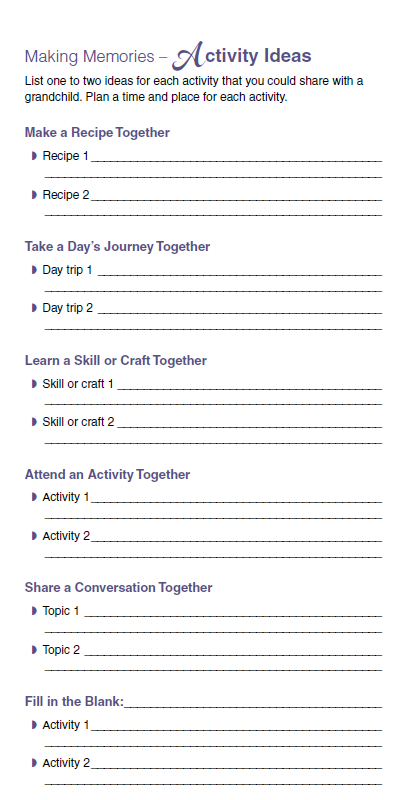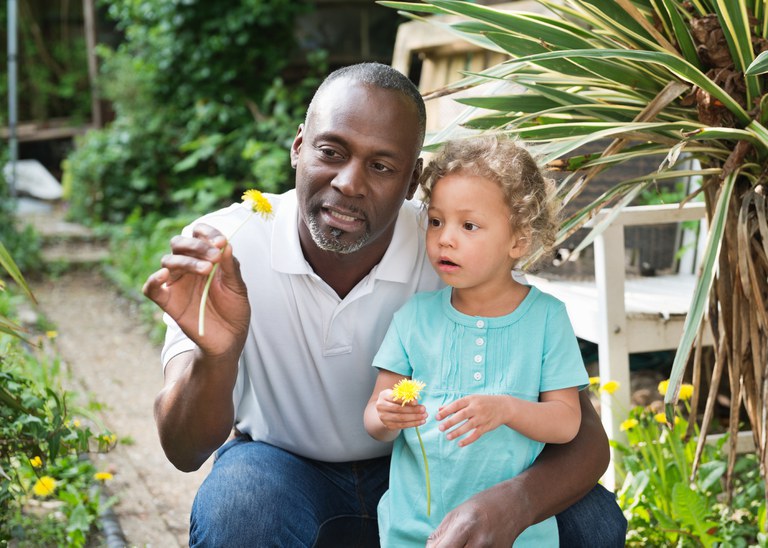The Art of Grandparenting No. 2: Making Memories for Grandchildren (FS1858, Revised Oct. 2020)
When an individual enters the role of grandparent, he or she often becomes a bridge to past generations for a grandchild. Such things as historical events, natural disasters, family triumphs and tragedies, and personal memories may get passed down to grandchildren.
Key roles grandparents occupy in family life can include being a family historian and acting as a mentor to younger generations. Stories, pictures, documents, recordings, home movies or videos all hold great value in linking to the past.
As a grandparent or stepgrandparent, consider how you might connect a grandchild with the past, preserve and pass on family memories and history, and make positive and lasting memories together in the present.
Grandparenting and Family Memories
One important family function that grandparents can promote in families is creating or passing on positive family memories. Reflect on any valued and positive memories that you may have experienced with your own grandparent, such as a shopping excursion, a camping trip or a meal together, or simply sharing a story with a grandparent. How can you facilitate such shared and positive memories with your own grandchildren?
Grandparents and stepgrandparents influence their grandchildren directly and indirectly. “Being there” for your grandchild can mean physically being present (direct) or emotionally being present (indirect).
When you make a phone call, attend an activity or go someplace together, you are influencing a grandchild directly. When a grandchild faces a challenging situation and thinks about you, knowing you are there to give support and be on his or her side, you are extending indirect influence by being there emotionally.
Among the roles grandparents play, some important ones linked with family memories include “stress buffer,” “family mentor,” “storyteller,” “teacher” and “family historian.” One of the most important things a grandparent can do is help grandchildren feel more connected to their families.
Why Make Memories?
Passing on personal or family memories is an activity that has a variety of important and useful purposes. Some of the reasons to create and pass on family memories are to:
- Connect family generations
- Bestow a sense of identity
- Teach family values
- Offer an awareness of the past and its lessons
- Practice generativity – caring for the next generation
- Experience personal meaning and resolution in later years

Connecting to Past Memories
Sharing who we are and how we have experienced life has great value for ourselves and for others, especially our family members and grandchildren. How does a grandchild come to know and care about who we are or what is important to us? It is often by the stories we tell. How does he or she come to know what has shaped our lives and identity? It is often by the memories we share with him or her.
One of the fun and interesting things you can do with a grandchild is take him or her on a guided tour of the past — your own!
Sharing Memories in the Present
Modern technology makes capturing and sharing personal or family memories easy to do using audio or video recording technologies. These life stories increase in value to family members as they grow older.
Most people have a powerful audio recorder or video camera — a smartphone — in their pocket or purse. Even if you’re not comfortable with a hand-held video camera, you can use a cellphone with video recording to create files that can be passed on easily. Also, many hand-held devices and smartphones contain audio recording apps or features that you can use to capture a story.
To capture one’s memories, make the effort to record significant events, people and places for present and future generations. Your family will appreciate the commentary and memories shared as you visit points from your past and present. A video not only captures family stories but also a grandparent’s voice, image and personality—something that only film can reproduce.
To share family memories in the present, follow these steps:
- Write down a starting list of stories or memories that you would like to capture.
- Decide on a time and place for the audio or video storytelling to occur. If possible, ask a grandchild to assist in the process. Responding to questions from another family member usually is easier for a grandparent.
- Prepare and practice with your audio or video capture technology—a video camera, smartphone, tablet or similar technology—and test it before you begin.
- Conduct a series of short recording sessions to capture and record the memories you want to preserve. Share the audio or video files with grandchildren and other family members. Send the memories you have captured by texting, messaging or emailing them, and also make certain to save the files in an organized place on a computer.
6 Options for Sharing Memories
Writing down a plan for your story recording efforts, including who, what, when and where, can help you make progress. Consider the following categories for sharing memories.
1. Family Memories
Interview parents, siblings, children, cousins or others. Have them tell some favorite family tales; describe family occasions or any other memorable events.
Show where your family lived. Take a tour of the home or property, if possible. Tell how it looked when you were growing up, the color of your room, with whom you shared a room.
What’s your ethnic heritage? Where did your ancestors come from? When did they immigrate to this country? How did they arrive? How old were they?
What are things you’d like to share regarding family traditions? What are some of the special practices or stories your family has passed down to each generation?
2. Education Memories
- Where did you go to school? Tour and show the building and grounds, if possible.
- Who were your friends during your school years? Meet or interview them and talk about the things you used to do together.
- Did you have favorite teachers or topics? Tell why you enjoyed them or their classes so much.
- What extracurricular activities did you participate in? Do you have any news clippings, uniforms or awards to show for these? How about team photos?
- Did you go to college or a technical school? If so, where and when? What did you study? What were the highlights of these years?
- How did you learn your trade or profession?
3. Neighborhood/Friends Memories
- Who lived next door, down the road or on your block? Who did you know well and with whom did you spend time? If possible, visit them and record memories or activities you used to do together. Bring out the photos, if possible.
- Take a drive through the neighborhood, video recording the countryside and places that had special meaning as you were growing up. These might include the local grocery store, places of sports competition, or places you played or went to church.
- Who were your friends? What activities did you do together?
- What special memories can you share from time with friends?
4. Marriage/Children Memories
- How did you meet your spouse or partner? How long did you court/date before you got married? Where and how did the proposal happen?
- Where were you married? Tour the church, courthouse or location, if possible. Describe the ceremony and your wedding day.
- Talk about your marriage if you feel comfortable. Share any partner traits, fun or interesting stories.
- Talk about the birth of your child(ren). Visit and show the location of where they grew up.
- What were activities your children did? Do you have pictures, news items or mementoes to share?
- Pass along favorite stories with your children.
5. Work Memories
- Tell about the jobs you’ve had throughout your life, including homemaking. Tour where you worked last or still are employed.
- What were some of the greatest challenges in your work? What were you paid on your first job?
- Discuss major accomplishments in your work. What did you do and when?
- Describe the volunteer work you’ve done through the years. These may have been in church or a nonprofit, at school or as an elected official, or for family members or neighbors.
- What are the fondest memories of your work? What are the benefits you got from work or service?
6. Holidays/Other Memories
What holidays did you celebrate? What holiday memories can you share?
Visit places where you did holiday activities and describe them.
Visit and discuss places or stories in your journey of faith.
Share aspects of your religion or spirituality that are meaningful in your life story.
Be creative! Talk about hopes, dreams, regrets. Tell your favorite jokes. Visit about your favorite hobbies; show the finished products.
Talk about, visit or share experiences from your “bucket list” — places you’ve traveled, things you have done, etc.
Making Memories for the Future
An important part of sharing who we are with a grandchild involves spending time together and making memories for the future. Activities can include making a recipe together, teaching a skill or craft, visiting a favorite location or enjoying a new adventure together. Your grandchild also could teach or share something with you! Plan some things you might do with a grandchild and prioritize the opportunity to make lasting memories you can share with each other.

Recommended Resources
Books
Spend time in local bookstores or an online bookstore and ask about memory books for grandparents. Many memory books allow you to share stories, put in pictures or pass on memories to grandchildren and other family members.
Johnson, S., Carlson, J., and Bower, E. (2010). Grandloving: Making memories with your grandchildren. Lancaster, Va.: Heartstrings Press. Also, visit www.grandloving.com.
LaBan, E. (2009). The grandparents handbook: Games, activities, tips, howtos, and all-around fun. Philadelphia: Quirk Books.
Videos
Visit the official YouTube channel of one or several family research organizations, such as Ancestry, MyHeritage, Findmypast or FamilySearch. Here you can find video playlists with dozens of educational videos about many aspects of finding, recording and sharing your personal history.
Organizations and Websites
engAGED – The National Resource Center for Engaging Older Adults – A project of The National Association of Area Agencies on Aging, this website provides varied resources on connecting across generations. Use the “Resources” link to access articles and other resources. Website: www.engagingolderadults.org/
Grandkids Matter – Supported by the National Association for Grandparenting, Grandkids Matter is an online resource center offering tips, videos, articles and other resources on grandparenting topics. Website: https://grandkidsmatter.org/
Grandloving.com – The Grandloving.com website offers a variety of useful tips, connection ideas and resources for grandparents and their family members. Website: www.grandloving.com/index.html
Passing on Family Memories, Resource handouts – Resource handouts for ideas on passing on family memories from the NDSU Extension Service. Website: www.ag.ndsu.edu/cff/family-andcommunity-education/copy_of_passing-on-family-memories
Zero to Three – The Grand-Connector – This site provides a resource for anyone caring for young children (infants, toddlers, etc.), with specific resources for grandparents. Website: www. zerotothree.org/resources/2464-the-grand-connector-grandparentresources
Personal and Family History Websites
Visit any of these well-known personal and family history websites for ideas and resources on making and sharing memories with your family members:
Ancestry – www.ancestry.com/
FamilySearch – www.familysearch.org/en/
Findmypast – www.findmypast.com/
MyHeritage – www.myheritage.com/
National Genealogical Society – www.ngsgenealogy.org/
References
Adler, E.S., and Hoffnung, M. (2018). Being Grandma and Grandpa: Grandparents share advice, insights and experiences. Grand Publications.
Brotherson, S.E. (2015, June). Passing on family memories (revised). Facilitators Guide, Family and Communication Education Club lesson materials. Fargo, N.D.: NDSU Extension Service.
DeHaan, L. (2006, revised). The influence of grandparents and stepgrandparents on grandchildren. Extension publication FS548. Fargo, N.D.: NDSU Extension Service.
Dunifon, R. (2013). The influence of grandparents on the lives of children and adolescents. Child Development Perspectives, 7(1), 55-60.
Johnson, S., Carlson, J., and Bower, E. (2010). Grandloving: Making memories with your grandchildren. Lancaster, Va.: Heartstrings Press.
Meyer, M.H., and Abdul-Malak, Y. (Eds.). (2017). Grandparenting in the United States (Society and Aging Series). New York: Routledge.
For more in The Art of Grandparenting series.


